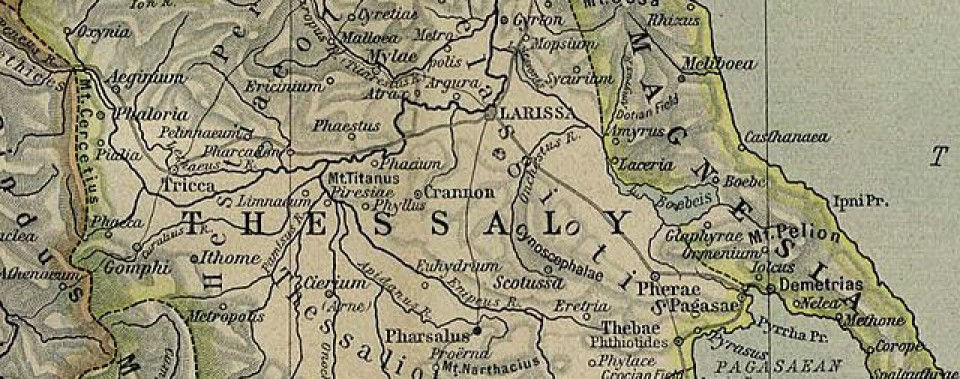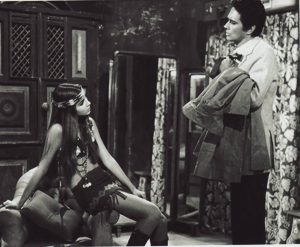One of my favourite movies is Julio Buch’s Spanish-made thriller The Trumpets Of The Apocalypse (1969), a co-production between Empire Films of Rome and Trebol of Madrid. This led to some Italian stars appearing in the cast, an Italian co-writer of the script and an Italian composer furnishing the soundtrack, but a largely Spanish crew and supporting cast. It is a film that has divided viewers over the years between those who love it and those who dismiss it. This may well depend on your attitude to Surrealism. Andre Breton and the French Surrealists loved strange/weird films like Henry Hathaway’s Peter Ibbetson (1935) and Louis Feuillade’s serial Les Vampires (1915). Trumpets is so strange, they would have probably loved it, too. It creates its own universe that seems far removed from the everyday world, which is a mark of Surrealist classics. Gianni Ferrio’s varied music score, sometimes quite spooky, helps create this atmosphere (it has been released on LP and CD).
Trumpets is a psychedelic, youth-oriented, violent murder mystery with a Spanish feel and is interesting on a number of counts. One of these is its depiction of the hippie counter culture of the late 60’s. The action centres around a Soho basement disco, The Mouse Hole. Although The Mouse Hole is meant to be “hep, man, the music there is psychedelic!”, its DJ Harry (Fabrizio Moroni) describes it as a “beatnik” joint, which in 1968/9 is rather anachronistic.

At The Mouse Hole
It is surely a ‘hippie’ joint, with posters of hippie heroes Bob Dylan (in the DJ’s booth), Jimi Hendrix and Arthur Brown (both on the entrance stairwell), as well as the fashionable ‘Lord Kitchener Wants You’ poster.
Leader ‘Loco’ (Miguel de la Riva, billed as Michael Rive) is clearly a hippie with his facial hair, clothes and drug-taking. His lair has graffiti on the walls typical of the hippie movement: ‘Make Love’ (not sure if it also says ‘Not War’), ‘We Shall Overcome’ and, above all, ‘LSD Not WWIII’. LSD was not a beatnik accoutrement.
The film is interesting in seemingly taking a critical stance on the counter culture. Tough guy Boris Molders (Manuel de Blas) “The Big Cat, The Roumanian”, who is the club bouncer, is clearly no hippie and is happy to use violence to get his way, whereas violence is verbally rejected by Loco on two occasions. But even the peacefully toking hippies are negatively portrayed as idlers, selfish pleasure-seekers who are not above using violence if it is to their advantage. The straight-laced but attractive hero Richard Milford (Brett Halsey) deplores The Mouse Hole as an “awful place”.
It clearly does not fit in with his world view of his gentleman’s club, luxury hotels (he stays at the expensive Hotel Russell in Russell Square) and elegant housing (Helen’s house in Bayswater).
What is even more interesting is what director Julio Buchs gets wrong in setting up this opposition between hippies and straights.
Harry has the LP of The Sound Of Music beside the turntable: Julie Andrews would never be played in a Soho psychedelic club of the era, far too uncool. Harry is playing a Reprise LP, but not one of the Reprise LP acts like The Electric Prunes who were “hep” at the time, but a kind of jazzy funk. (Reprise was started by Brett Halsey’s social friend Frank Sinatra.) And as Brian Horowitz of ‘Trash Palace’ has pointed out in a comment on the film, it is hilarious that the dancing in the club has to stop while Harry takes the LP off the turntable to turn it over to the other side. (Brett Halsey thought that Buchs was probably too old to know what went on in discos, he was in his 40s when he made the film. Nevertheless, he said he found Buchs “very talented and dedicated”.)
The film is on much more confident ground in exploring the characters’ personal morality, which is perverse: the film has been released as Perversion Story, as I Caldi Amori di Una Minorenne 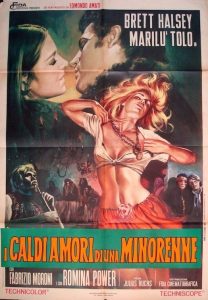 and as Murder By Music. Although there is a conventional romance between the leading actors Halsey and Marilu Tolo as Helen, there is (for a 1969 film) an unusual allusion to the gay scene when Halsey is accosted (“Psstt…”) by a gay man wearing a chain outside the club, for no narrative reason except to portray The Mouse Hole clientele as depraved. More subtle is the placing of a lesbian couple as Richard enters The Mouse Hole, one with a butch haircut and a cigarette holder.
and as Murder By Music. Although there is a conventional romance between the leading actors Halsey and Marilu Tolo as Helen, there is (for a 1969 film) an unusual allusion to the gay scene when Halsey is accosted (“Psstt…”) by a gay man wearing a chain outside the club, for no narrative reason except to portray The Mouse Hole clientele as depraved. More subtle is the placing of a lesbian couple as Richard enters The Mouse Hole, one with a butch haircut and a cigarette holder.

Fanny and Boris
Much the most perverse character is Fanny (Romina Power), who clearly gains sexual excitement from violence and seems to be drawn to the victor in any conflict. Although she is introduced as Boris’ girlfriend, telling him at one point “I care about you, Boris”, she seems to betray him by rescuing Richard from Boris’ thugs and trying to seduce him. She seems quite disappointed when Richard refuses her, though she later tells Boris she only brought Richard there to find out what he was planning against Boris. However, it becomes clear she was lying when she asks Richard back to her place once again when they meet at The Mouse Hole. He makes it very clear (“never”) he is not interested and she is quite angry. This leads her to side with Loco after Boris’ death so she can punish Richard and punish him she does, watching with pleasure as Loco’s men attack him, stabbing out a cigarette on his chest and condoning Helen being raped. Even when the Police intervene and arrest her, she is simply sorry that her “fun” is over.
Romina Power’s completely amoral performance is one of the film’s great strengths, once seen hard to forget. She has no loyalty to Boris, to Richard or to Loco, she is only interested in dancing and sexual excitement gained from a perverse enjoyment of fighting. Her face is filled with pleasure when she sees Richard fighting with Loco’s men at The Mouse Hole. She even tells Richard “I have always loved to watch a fight. Tonight I’m all yours.” She is also promiscuous: she protests when Richard rejects her that he is the first man who has ever turned her down. She is also vain, asking if he has seen what she looks like, and pleased when he concedes that she is beautiful.
The ‘perversion’ of the film’s title Perversion Story is probably to do with the effect of listening to the Trumpets music under the influence of the psychedelic drug but along the way is much depiction of perversion: Boris violently whipping a defenceless Loco lying prone on the ground, endless pipe-smoking of drugs (opium or pot is not made clear), promiscuous women (the girl ‘Rembrandt’ propositions Richard early on at his sister’s boarding house),

Rembrandt propositions Richard
Harry’s murdering Boris and Albert because they might talk, etc. The characters who are not in some way perverse are presented as fools: the taxi driver, the hotel receptionist and, above all, the Police, who can’t seem to puzzle out what is happening.
Because the film, which is set in London, was filmed on both actual London locations and in Madrid studio mock-ups, it presents a very odd hybrid view of London, which adds to the surreal look of the whole film, as in some scenes London is drenched in fog, accompanied by Gianni Ferrio’s unsettling score, and populated by helmet-wearing beat bobbies on foot who blow their whistles for assistance.
The real location filming included Richard at Tower Bridge arriving by boat; his taxi across Westminster Bridge into Trafalgar Square and Pall Mall; Harry running down Walker’s Court in Soho, off Brewer Street; Helen at the grave (I thought it looked like Hendon Cemetery but could not find the filmed headstones there and Hendon keep no records of filming, so it might be another London cemetery); Richard in Coventry Street, Piccadilly Circus; the Hotel Russell; the Royal Academy of Music, Marylebone Road; Helen’s house at 25 Radnor Place, Bayswater; Pinkerton the beggar in Gloucester Square, Bayswater;

Pinkerton in Gloucester Square
the Albert Memorial; Hyde Park; the Royal Albert Hall, into Prince Consort Road; the Tower of London. Fake London locations, shot in Madrid, were The Mouse Hole in Soho; Sloane Square outside Loco’s lair; Fanny’s nest; Pinkerton’s junk yard in Whitechapel; Boris’ flat at 18 Moon Street; Loder’s Bar (fictitious) near Boris’ flat.
Most of the film is shot at night (well-photographed by Manuel Rojas who shot Dustin Hoffman’s first film Madigan’s Millions) or indoors. Only a few scenes are in daytime but even they have a subdued feel to them, possibly due to the film stock used.

Police arrive opposite Helen’s house
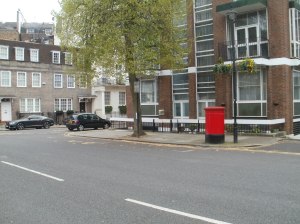
Location little changed in 2016
There are no bright colours. Even Richard’s approach to the Hotel Russell is in the evening. This makes the film very downbeat, in keeping with Richard’s sorrowful demeanour mourning his sister Catherine. It also makes the film somewhat oneiric, like a bad dream or nightmare.

Looking down Radnor Place
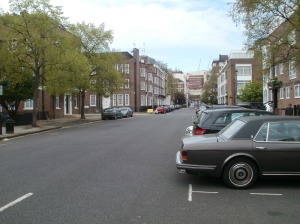
Radnor Place in 2016
On the other hand, one of the values of the film is as a snapshot of London’s cinematic and pop culture of the late 60s. At The Mouse Hole, there are posters on the wall for Marlene Dietrich and Brett Halsey’s then-wife Heidi Bruhl (brought from Rome by him as an in-joke). In a bizarre sequence, ‘Prophet’ takes Richard to Loco’s lair in a place which a street sign hilariously proclaims as ‘Sloane Square’ but is a desolate nowhere. (I suspect Buchs bought one of those tourist-aimed London street signs one can buy, there is one of ‘Carnaby Street’ at Fanny’s nest visible not in the film but in a

‘Carnaby Street’ at Fanny’s nest
production still. He probably thought it would not be readable seen fleetingly on a cinema screen, in the days before digital media.) Beside the street sign is a poster for the 1967 film Terence Young’s Wait Until Dark and a poster for newsreel Pathe News. After leaving Loco, Richard is attacked in front of a poster for Freddie Francis’ Dracula Has Risen From The Grave (1968) as well as a milk promotion poster (Pinta).

Richard attacked by Boris’ men
Fanny’s nest is festooned with pop group and pop singer posters, some probably Italian, the most noticeable poster being for Beatles’ protégé Mary Hopkin, who had a big hit with her record Those Were The Days.
After leaving The Mouse Hole when the Police turn up, Richard walks down Great Windmill Street past the Cameo Moulin Cinema which is showing a notorious soft porn film of the time, Norman J. Warren’s Her Private Hell (1968). Twice (once in a taxi, once on foot) Richard passes the London Pavilion Cinema which is showing big hit Mike Nichols’ The Graduate (1967).
The film was bought for distribution in the UK nearly two years after its Italian release by small distributor E.J. Fancey, who bought a lot of Italian commercial films and put them out to independent cinemas rather than the big chains, often on late night showings. I first saw it in 1971 or 1972 on a late bill at the Classic, Charing Cross Road, an insalubrious venue where vagrants came to sleep. When they took their shoes off, the smell was atrocious and the manager walked around spraying the air. I thought it might be disinfectant. The best possible conditions in which to view this film, it has to be said. Quite perverse. It played on the London late night circuit for a few years.
(The website http://cinematreasures.org/theaters/1916 confirms it was disinfectant.
Junior manager of the cinema Ali Ismail writes: “It was (in)famous for the all-night screenings which attracted the most amazing collection of knights of the road and bag ladies. The smell was terrible and I fully believe the account of urinating in the seats….Sometimes the staff sprayed disinfectant into the air – it was needed!” ‘AdoraKiaOra’ also writes: “One of the most awful, dirty and dangerous cinemas I’ve ever had the misfortune to visit – ever! It showed second run movies or worse. It was mainly visited by vagrants and tramps.” ‘JFM’ concurred: “It was a dreadful place…it was basically a glorified vagrants hostel. They used to charge a flat fee of a pound or so, and you could stay all night, and get free coffee. But it just attracted all the vagrants, drunks and other unsavoury characters.”)
The Monthly Film Bulletin (March 1971) review was not enthusiastic, finding it “ramshackle”, “unlikely” and implausible. Reviewer Kenneth Thompson, a fan of 1930s British film comedian Jack Hulbert, was probably not the best person to be asked to review this kind of film. I have not seen any other UK reviews. E. J. Fancey did not promote their releases with press showings or advertisements on the whole and I have not come across a UK poster.
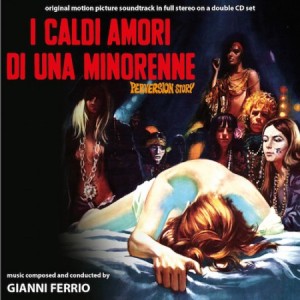
E. J. Fancey re-named the film Again, a fairly meaningless choice unless E.J. Fancey were referring to the re-teaming of Brett Halsey and Marilu Tolo, who had been widely seen in Tulio Demicheli’s Espionage in Lisbon in UK cinemas during the spy film boom. This is just guesswork, though.
The E.J. Fancey plot synopsis issued to the industry is interesting on a couple of counts. Firstly, it is wrong. Professor Stone is the first to die, not Catherine. It is when Harry reads of Stone’s death in the newspaper (so presumably the next day) that he rushes to try to save Catherine from the same fate. The Monthly Film Bulletin’s synopsis is similarly wrong, though the wording is different. Secondly, both synopses refer to Boris as ‘Hans’. Was he changed from a German national to a Roumanian at the dubbing stage? If so, why? To avoid offence to the German market? Presumably the Roumanian market was not an issue. Both synopses spell the name of Richard’s sister as ‘Catherine’. The Inter-Ocean video sleeve spells it ‘Katherine’.
When the film was released on VHS by Inter-Ocean Video in the UK in 1981 as Perversion Story, this led to some misunderstandings, as it got put into the soft porn sections of video stores.  I asked to buy the single copy in the glass cabinet, surrounded by striptease videos of the Electric Blue series, in one of those electronics stores in Tottenham Court Road which had a video retail section. The salesman, who must have seen the film and been sorely disappointed, disapproved of my choice and tried to steer me towards something “hotter”!
I asked to buy the single copy in the glass cabinet, surrounded by striptease videos of the Electric Blue series, in one of those electronics stores in Tottenham Court Road which had a video retail section. The salesman, who must have seen the film and been sorely disappointed, disapproved of my choice and tried to steer me towards something “hotter”!
The film gained nearly a million admissions in Spain, where Brett Halsey was then very popular, but was less successful elsewhere. Halsey said in 2004: “I was surprised that Perversion Story didn’t get a bigger release.”  I think that one of its problems for being accepted by a wide audience is the complexity of the exposition, which makes following the plot not easy, certainly on one viewing. I must have seen the film six times before I began to fathom out the plot, due to the complex exposition and distraction by the surface visuals and the music.
I think that one of its problems for being accepted by a wide audience is the complexity of the exposition, which makes following the plot not easy, certainly on one viewing. I must have seen the film six times before I began to fathom out the plot, due to the complex exposition and distraction by the surface visuals and the music.
There are still some things I am unclear about, mainly to do with the behaviour of the beggar Pinkerton. Why is he stalking Richard? Is he being paid by Harry, who used him to kill Boris? Why does Harry want to involve Richard? How did Harry transfer the music he copied from the original score to Pinkerton’s ancient hurdy gurdy? Is it in fact a hurdy gurdy or an organette music box with metal disc?
The film has been classified as a ‘giallo’ (murder mystery) but differs from the Italian template of such films, as there is a traditional ‘MacGuffin’ (plot generator) in the form of the music of the Trumpets heard under a psychedelic drug, but the exposition is rather perfunctory for such an important revelation of the cause of the various deaths. Not only that, the script contradicts itself without explanation, which is confusing for the audience.

Professor Clifford at the Royal Academy of Music describes the Trumpets of the Apocalypse as a “strange composition of 18th century for stringed instruments only, the title is very odd”: “The author was a little-known composer at the Court of Saxony, in fact he died in the madhouse.” But Albert Stone later translates Arabic script on the score that says: “This symphony was composed in the land of Mesopotamia, composed under the influence of a paradisiac distillation of a weed called Ibogain.” What happened to the Court of Saxony?

Of course, there were three writers giving input, the director Buchs, the Spanish Federico de Urrutia and the Italian Sandro Continenza. de Urrutia wrote other pictures for Buchs (A Bullet For Sandoval) and paella Westerns. Continenza had an amazing career writing memorable Italian commercial films, including Hercules Conquers Atlantis, Mission Bloody Mary, Hannibal, Master Stroke, Crimes Of The Black Cat, The Living Dead At The Manchester Morgue, Inglorious Bastards, etc. Other credits are more obscure, due to the unfortunate practice of giving Spanish and Italian performers and crew made-up American or English-sounding names. The film is edited by ‘Anthony Rambledon’ and ‘Vincent Thomas’ who have no other credits on imdb.com, but are in fact Antonio Ramirez and Vincenzo Tomassi who have many other credits. Ramirez too worked on Madigan’s Millions and Tomassi, who had already worked for Riccardo Freda, would edit many Lucio Fulci pictures, including two of Brett Halsey’s best later pictures. Who was ‘Gray Hudson’, Production Supervisor, in reality?
The English language film print, the imdb.com listing and the Monthly Film Bulletin do not offer a proper cast list. Principal actors are Brett Halsey (Richard Milford), Marilu Tolo (Helen Baker), Romina Power (Fanny), Fabrizio Moroni (Harry), Manuel de Blas (Boris Molders), Albert Dalbes (Albert Stone), Lili’ Murat (Stone’s widow), Gerard Tichy (Police commissar), Dan Van Husen (Thug), Oscar Pellicer, John Fontaine, Javier La Puente, Paco Sanz. Who plays Inspector Crane? Who plays Rembrandt? Is John Fontaine a pseudonym for Javier La Puente? (The Monthly Film Bulletin credits Javier La Puente but not John Fontaine, the film print and the imdb listing credit John Fontaine but not Javier La Puente.) This is hopeless. The same slipshod approach led to the last words of the English language print being spoken in Italian only, presumably a mistake by the dubbers but quite a jolt for the viewer. Hopefully when the film makes it to Blu Ray, this will be corrected.
There are some strong performances in the film. A very memorable character in the film is Loco, nicely played by Spanish actor Miguel de la Riva, who is credited as Michael Rive and is sometimes credited as Michael Rivers. Asked by Richard for his name, he replies “I have no name. People call me Loco, but I think other people are loco.” He acts permanently stoned or high on the substances he is smoking, which makes him a very convincing hippie. In one scene, Loco is toking at midnight, laughing manically, his face painted white – an eerie precursor of Jack Nicholson’s Joker and also reminiscent of Walter Huston as the Devil in The Devil And Daniel Webster (1941). Riva later played a conventional cowboy in Rebels of Arizona (1970), nothing like Loco, which shows what a good actor he was. He had worked in Rome making peplums before returning to Madrid. A friend who knew him in Madrid in the 80s writes that he had taken to drinking and reminiscing about his career, lamenting that he never achieved the popularity of a Clint Eastwood but full of amusing anecdotes.
The role of Loco was first offered to German actor Dan Van Husen, who played one of the thugs in the end. According to Van Husen, he had no permission from the Spanish actors’ Union, Syndicato Espectacolo, and they insisted on a Spanish actor and he “carried no weight” as an actor, so there was nothing he could do.
Albert Stone (played by Albert Dalbes, who worked with Jess Franco) was voiced in the English language print by well-known voice artist David de Keyser, who dubbed Gabriele Ferzetti in the James Bond film OHMSS (1969). de Keyser also voiced the boat skipper who jokes with Richard on his arrival at Tower Bridge at the start. His silky tones help Dalbes’s performance.
I do not know who dubbed Brett Halsey’s voice, but it does not harm his performance too much, as there is some similarity in places, and Halsey’s facial expressions are so strong throughout the film. It is one of Halsey’s finest performances, maybe because it is possibly the most sustained downbeat performance he ever gave, due to the character’s sorrow and worry. Halsey was extraordinarily photogenic at this time in his career and certainly the screen equal of the more celebrated Alain Delon. His impressive presence holds the picture together, despite the crazy happenings depicted.

Outside the house in Radnor Place
